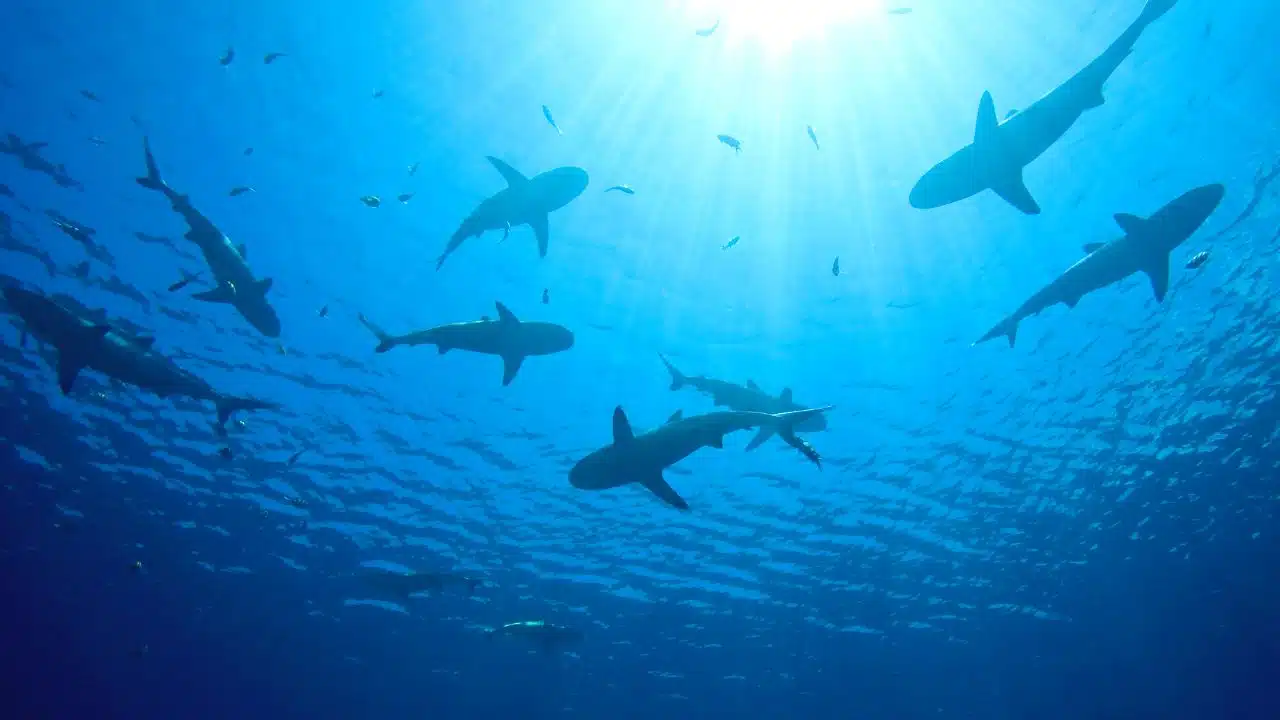The movie Jaws may have inspired a less-than-healthy fear of these creatures. Because, while the multiple rows of sharp teeth may imply otherwise, a shark is actually less likely to kill you than a bolt of lightning or a stray cork from a champagne bottle. Of course, that may do little to calm your fears when standing on Hawaiian shores with the open ocean in front of you and the Jaw’s theme music playing in your head. So, it might be worth taking a closer look at sharks in Hawaii and how these cold-blooded fish may affect your long-awaited vacation.
Table of Contents
- 7 Frequently Asked Questions About Sharks in Hawaii
- 5 Tips for How to Avoid a Shark Attack in Hawaii
- If Sharks Won’t Put You Off, Don’t Let Expensive Airfare Get in the Way—Fly with Next Vacay
7 Frequently Asked Questions About Sharks in Hawaii
Do you have to leave the ocean to them while you enjoy the beach? Not exactly. Despite Hollywood trying to convince us otherwise, sharks aren’t nearly as intimidating or interested in humans as you may believe. So, let’s tackle some of your biggest burning questions about sharks in Hawaii so that you can dive into the waters worry-free.
1. Are There Sharks in Hawaii?
The beautiful Hawaiian waters hide a secret; they’re teeming with sharks.
Of course, this comes as little surprise, as the open ocean is home to all manner of sea creatures and shark species, from the intimidating tiger shark to the abundant blacktip reef shark.
Thanks to the diverse sharks found in Hawaii, shark encounters are a popular tourist activity on the islands. And while some people pay for their shark adventures, if you go swimming at certain beaches, like the gorgeous Hanauma Bay or the scenic Kaneohe Bay, you may encounter them doing as you’re doing and enjoying the ocean—or better yet, getting a tan!
2. Which Hawaiian Island Has the Most Sharks?
The beauty of Maui beaches is tempered only by the fact that it’s the most likely island for eager beach-goers to encounter a shark in Hawaii. After a string of incidents in 2012 and 2013, a shark tracking study revealed that Maui’s shelf habitat is a hotbed for tiger sharks.
Thanks to this study, we know that Maui sees the most tiger sharks, and as a result, it also experiences the most shark attacks. However, despite the abundance of sharks and people on Maui’s coasts, scientists were surprised by how few shark attacks have occurred in Hawaii.
Of course, that’s good news for travelers, as it means that despite their abundance, most visitors to Hawaii will never see a shark—unless they want to.
3. How Many Species of Sharks Are in Hawaii?
Over 40 shark species swim in the waters and coral reefs surrounding Hawaii, ranging from the eight-inch pygmy shark to the 50-foot-plus whale shark.
While most are completely harmless, some are decidedly less so. Several of the most dangerous sharks in the world have been spotted off the coasts of Hawaii, including tiger sharks and great whites.
4. What Are the Most Common Sharks in Hawaii?
Though often curious, even the most dangerous sharks in Hawaii aren’t known to attack humans very often. But, on the off-chance you encounter a shark in Hawaii, here are the most common shark species to look out for.
Whitetip Reef Sharks
One of the most common shark species in Hawaii is the whitetip reef shark, recognizable for the white tips on its top dorsal and tail fins. Often seen resting in caves and swimming among coral reefs, whitetip reef sharks are fairly harmless.
Galapagos Sharks
Named after the Galapagos Islands, the Galapagos shark is found worldwide in tropical ocean regions. Not only are Galapagos sharks cannibals, but they also have a unique ability to push their stomachs out through their mouths. Talk about nightmare-inducing.
But although they’re considered potentially dangerous to humans, there have been few recorded biting incidents, and unprovoked attacks are uncommon.
Sandbar Sharks
The sandbar shark is one of the largest coastal sharks in the world, and one of the most common on the Atlantic coast, though it doesn’t bear any distinct markings, just a sharp profile.
Due to its size, it can be dangerous. However, as the name implies, the sandbar shark generally avoids the surface, preferring to swim along the ocean’s sandy bottom instead.
Scalloped Hammerhead Sharks
Most people recognize a hammerhead shark, but did you know that not all have a smooth head? The scalloped hammerhead shark is identifiable thanks to the indentations along its head.
If you’re swimming around the beaches of Hilo Bay, Kaneohe Bay, or Waimea Bay, you may catch these sharks coming in closer to shore to pup.
Tiger Sharks
The most dangerous shark lurking in Hawaii’s waters is also one of the most common, especially if you’re visiting the island of Maui.
Coming in as the fourth largest shark in the world, tiger sharks are recognizable for the vertical lines along their sides. And just as it shares a name with its striped, dry-land counterpart, the tiger shark is an aggressive predator with a wide-ranging diet known to include green sea turtles and monk seals.
5. What Is the Most Dangerous Shark in Hawaii?
While any shark can be dangerous if provoked, not much competition is given to the most dangerous shark in Hawaii: the tiger shark.
According to the International Shark Attack File, tiger sharks rank only second to great whites in attacks against humans. And although great whites certainly give them a run for their money, they’re just unusual enough in Hawaii to crown the tiger shark as king of the seas.
While it’s not known why tiger sharks attack humans, they are the most likely culprit when a biting incident occurs.
Thankfully, shark incidents in Hawaii are few and far between, and just because you spot a shark in the water doesn’t always mean trouble.
6. How Rare are Shark Attacks in Hawaii?
Shark attacks, in general, are extremely rare, and fatal shark attacks are even less so. Just how rare? Over the last 16 years, only 126 shark bites have been recorded in Hawaii. Maui reported the most incidents at 45, with only five fatal shark bites.
As the saying goes, you’re in more danger from a falling coconut than an attacking shark. And while those numbers may have been exaggerated, it is true that few things are less statistically likely to kill you than a shark attack.
So, you can enjoy the beaches of Maui and the other Hawaiian Islands without fear—of sharks in the water or falling coconuts!
7. Is It Safe to Swim in Hawaii?
So, what do sharks in the water mean for swimming? Only that it’s completely safe. On average, only three to four fatal shark attacks occur annually in Hawaiian waters. Considering the number of sharks in Hawaii and the millions of annual visitors, that means you’re unlikely to experience an encounter yourself, fatal or otherwise.
So, nab a deal with Next Vacay, kick back, and relax under the Hawaiian sun, lounging on the beach or hanging ten out on the water. If not wholly worry-free, then pretty close to it.
5 Tips for How to Avoid a Shark Attack in Hawaii
While there’s no need to spend your entire trip worrying about shark attacks in Hawaii, it never hurts to be prepared. Here are five top tips for staying safe and avoiding sharks in Hawaii.
1. Know the Safe Times to Swim
Avoid swimming at dawn, dusk, or night. Many shark species move inshore at this time to feed. So, even if you were looking forward to being the first one out on the water, consider hanging back till the sun gets some height or waiting until a few others can join you out on the waves.
2. Don’t Swim Alone
Whether it’s the sharks or the waves, braving Hawaii’s waters alone is never a good idea. And though you may want to bring your pet, their chaotic swimming patterns can actually draw out sharks.
Always plan your favorite water-based activities—swimming, surfing, snorkeling, etc.—with other people. And try to keep from excessive splashing or flashy clothing/jewelry, which may also attract sharks.
3. Don’t Swim Near People Fishing or Spearfishing
Sharks have many enviable senses, one of which is their sense of smell. They can detect bodily fluids to one part per 10 billion parts of water, meaning a shark can smell blood even from hundreds of yards away. So, avoid areas where others are fishing, or there’s fish chum in the water.
P.S. Sharks’ sense of smell is so good they can tell the difference between fish blood and human blood, and they’re not particularly interested in the latter. We still wouldn’t recommend swimming with an open wound, though.
4. Be Aware of Your Surroundings
Sharks are hyper-aware of their surroundings, and it’s a good idea for you to be too. So, if you spot a shark, calmly and quickly make your way out of the water. And if you see fish, sea turtles, or even marine mammals acting strangely, it may be time to take a break from the water.
5. Know Where Not to Swim
Knowing where you shouldn’t swim is also one of the best ways to avoid sharks and lessen your chances of a shark attack in Hawaii. Murky waters, stream mouths, harbor entrances, and steep dropoffs are favorite hangout spots for sharks, often because they make great feeding locations. So, do your best to avoid these kinds of areas and stick to clear waters where you can see danger coming.
If Sharks Won’t Put You Off, Don’t Let Expensive Airfare Get in the Way—Fly with Next Vacay
If you don’t have to worry about sharks in Hawaii, you shouldn’t have to worry about getting to Hawaii. For that, there’s Next Vacay.
With a team of savvy deal hunters and a dedicated customer service team, you’ll be saying Aloha to the Hawaiian Islands in no time. Vetted deals are sent to your inbox so you can book directly with the airline—no middleman involved, just hundreds of dollars of savings. Book your ticket, then book your shark encounter … or plan your sandy beach day. It’s all possible when you fly with Next Vacay!



